Katherine A. Skinner
Field Report on Ground Penetrating Radar for Localization at the Mars Desert Research Station
Apr 21, 2025Abstract:In this field report, we detail the lessons learned from our field expedition to collect Ground Penetrating Radar (GPR) data in a Mars analog environment for the purpose of validating GPR localization techniques in rugged environments. Planetary rovers are already equipped with GPR for geologic subsurface characterization. GPR has been successfully used to localize vehicles on Earth, but it has not yet been explored as another modality for localization on a planetary rover. Leveraging GPR for localization can aid in efficient and robust rover pose estimation. In order to demonstrate localizing GPR in a Mars analog environment, we collected over 50 individual survey trajectories during a two-week period at the Mars Desert Research Station (MDRS). In this report, we discuss our methodology, lessons learned, and opportunities for future work.
SonarSplat: Novel View Synthesis of Imaging Sonar via Gaussian Splatting
Mar 31, 2025



Abstract:In this paper, we present SonarSplat, a novel Gaussian splatting framework for imaging sonar that demonstrates realistic novel view synthesis and models acoustic streaking phenomena. Our method represents the scene as a set of 3D Gaussians with acoustic reflectance and saturation properties. We develop a novel method to efficiently rasterize learned Gaussians to produce a range/azimuth image that is faithful to the acoustic image formation model of imaging sonar. In particular, we develop a novel approach to model azimuth streaking in a Gaussian splatting framework. We evaluate SonarSplat using real-world datasets of sonar images collected from an underwater robotic platform in a controlled test tank and in a real-world river environment. Compared to the state-of-the-art, SonarSplat offers improved image synthesis capabilities (+2.5 dB PSNR). We also demonstrate that SonarSplat can be leveraged for azimuth streak removal and 3D scene reconstruction.
These Magic Moments: Differentiable Uncertainty Quantification of Radiance Field Models
Mar 20, 2025Abstract:This paper introduces a novel approach to uncertainty quantification for radiance fields by leveraging higher-order moments of the rendering equation. Uncertainty quantification is crucial for downstream tasks including view planning and scene understanding, where safety and robustness are paramount. However, the high dimensionality and complexity of radiance fields pose significant challenges for uncertainty quantification, limiting the use of these uncertainty quantification methods in high-speed decision-making. We demonstrate that the probabilistic nature of the rendering process enables efficient and differentiable computation of higher-order moments for radiance field outputs, including color, depth, and semantic predictions. Our method outperforms existing radiance field uncertainty estimation techniques while offering a more direct, computationally efficient, and differentiable formulation without the need for post-processing. Beyond uncertainty quantification, we also illustrate the utility of our approach in downstream applications such as next-best-view (NBV) selection and active ray sampling for neural radiance field training. Extensive experiments on synthetic and real-world scenes confirm the efficacy of our approach, which achieves state-of-the-art performance while maintaining simplicity.
MarsLGPR: Mars Rover Localization with Ground Penetrating Radar
Mar 06, 2025Abstract:In this work, we propose the use of Ground Penetrating Radar (GPR) for rover localization on Mars. Precise pose estimation is an important task for mobile robots exploring planetary surfaces, as they operate in GPS-denied environments. Although visual odometry provides accurate localization, it is computationally expensive and can fail in dim or high-contrast lighting. Wheel encoders can also provide odometry estimation, but are prone to slipping on the sandy terrain encountered on Mars. Although traditionally a scientific surveying sensor, GPR has been used on Earth for terrain classification and localization through subsurface feature matching. The Perseverance rover and the upcoming ExoMars rover have GPR sensors already equipped to aid in the search of water and mineral resources. We propose to leverage GPR to aid in Mars rover localization. Specifically, we develop a novel GPR-based deep learning model that predicts 1D relative pose translation. We fuse our GPR pose prediction method with inertial and wheel encoder data in a filtering framework to output rover localization. We perform experiments in a Mars analog environment and demonstrate that our GPR-based displacement predictions both outperform wheel encoders and improve multi-modal filtering estimates in high-slip environments. Lastly, we present the first dataset aimed at GPR-based localization in Mars analog environments, which will be made publicly available upon publication.
OceanSim: A GPU-Accelerated Underwater Robot Perception Simulation Framework
Mar 03, 2025Abstract:Underwater simulators offer support for building robust underwater perception solutions. Significant work has recently been done to develop new simulators and to advance the performance of existing underwater simulators. Still, there remains room for improvement on physics-based underwater sensor modeling and rendering efficiency. In this paper, we propose OceanSim, a high-fidelity GPU-accelerated underwater simulator to address this research gap. We propose advanced physics-based rendering techniques to reduce the sim-to-real gap for underwater image simulation. We develop OceanSim to fully leverage the computing advantages of GPUs and achieve real-time imaging sonar rendering and fast synthetic data generation. We evaluate the capabilities and realism of OceanSim using real-world data to provide qualitative and quantitative results. The project page for OceanSim is https://umfieldrobotics.github.io/OceanSim.
LiHi-GS: LiDAR-Supervised Gaussian Splatting for Highway Driving Scene Reconstruction
Dec 19, 2024



Abstract:Photorealistic 3D scene reconstruction plays an important role in autonomous driving, enabling the generation of novel data from existing datasets to simulate safety-critical scenarios and expand training data without additional acquisition costs. Gaussian Splatting (GS) facilitates real-time, photorealistic rendering with an explicit 3D Gaussian representation of the scene, providing faster processing and more intuitive scene editing than the implicit Neural Radiance Fields (NeRFs). While extensive GS research has yielded promising advancements in autonomous driving applications, they overlook two critical aspects: First, existing methods mainly focus on low-speed and feature-rich urban scenes and ignore the fact that highway scenarios play a significant role in autonomous driving. Second, while LiDARs are commonplace in autonomous driving platforms, existing methods learn primarily from images and use LiDAR only for initial estimates or without precise sensor modeling, thus missing out on leveraging the rich depth information LiDAR offers and limiting the ability to synthesize LiDAR data. In this paper, we propose a novel GS method for dynamic scene synthesis and editing with improved scene reconstruction through LiDAR supervision and support for LiDAR rendering. Unlike prior works that are tested mostly on urban datasets, to the best of our knowledge, we are the first to focus on the more challenging and highly relevant highway scenes for autonomous driving, with sparse sensor views and monotone backgrounds.
VAIR: Visuo-Acoustic Implicit Representations for Low-Cost, Multi-Modal Transparent Surface Reconstruction in Indoor Scenes
Nov 07, 2024



Abstract:Mobile robots operating indoors must be prepared to navigate challenging scenes that contain transparent surfaces. This paper proposes a novel method for the fusion of acoustic and visual sensing modalities through implicit neural representations to enable dense reconstruction of transparent surfaces in indoor scenes. We propose a novel model that leverages generative latent optimization to learn an implicit representation of indoor scenes consisting of transparent surfaces. We demonstrate that we can query the implicit representation to enable volumetric rendering in image space or 3D geometry reconstruction (point clouds or mesh) with transparent surface prediction. We evaluate our method's effectiveness qualitatively and quantitatively on a new dataset collected using a custom, low-cost sensing platform featuring RGB-D cameras and ultrasonic sensors. Our method exhibits significant improvement over state-of-the-art for transparent surface reconstruction.
Conformalized Reachable Sets for Obstacle Avoidance With Spheres
Oct 13, 2024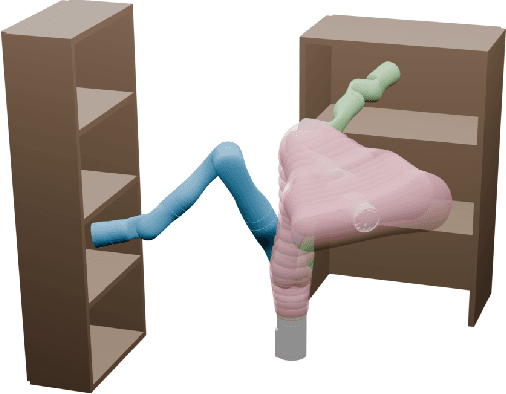
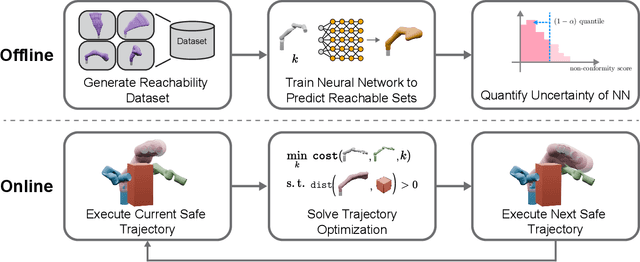
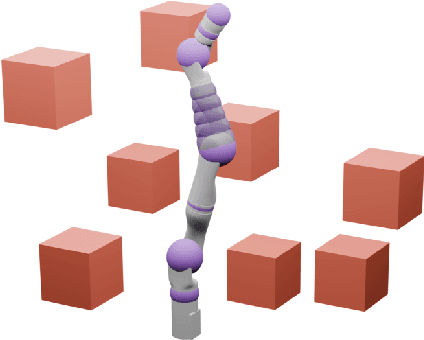
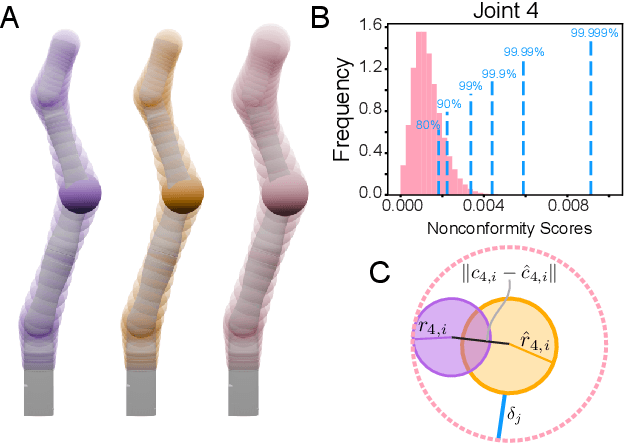
Abstract:Safe motion planning algorithms are necessary for deploying autonomous robots in unstructured environments. Motion plans must be safe to ensure that the robot does not harm humans or damage any nearby objects. Generating these motion plans in real-time is also important to ensure that the robot can adapt to sudden changes in its environment. Many trajectory optimization methods introduce heuristics that balance safety and real-time performance, potentially increasing the risk of the robot colliding with its environment. This paper addresses this challenge by proposing Conformalized Reachable Sets for Obstacle Avoidance With Spheres (CROWS). CROWS is a novel real-time, receding-horizon trajectory planner that generates probalistically-safe motion plans. Offline, CROWS learns a novel neural network-based representation of a spherebased reachable set that overapproximates the swept volume of the robot's motion. CROWS then uses conformal prediction to compute a confidence bound that provides a probabilistic safety guarantee on the learned reachable set. At runtime, CROWS performs trajectory optimization to select a trajectory that is probabilstically-guaranteed to be collision-free. We demonstrate that CROWS outperforms a variety of state-of-the-art methods in solving challenging motion planning tasks in cluttered environments while remaining collision-free. Code, data, and video demonstrations can be found at https://roahmlab.github.io/crows/
MemFusionMap: Working Memory Fusion for Online Vectorized HD Map Construction
Sep 26, 2024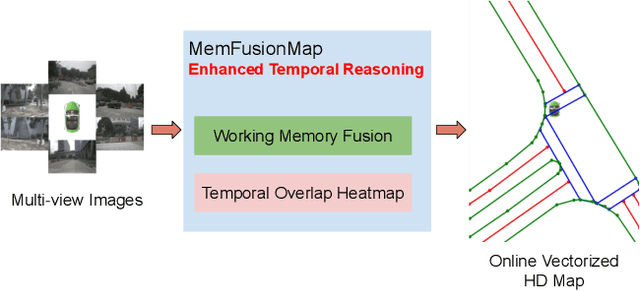

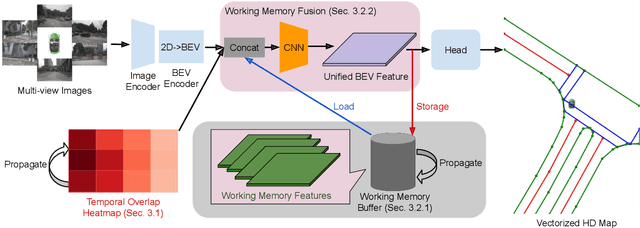

Abstract:High-definition (HD) maps provide environmental information for autonomous driving systems and are essential for safe planning. While existing methods with single-frame input achieve impressive performance for online vectorized HD map construction, they still struggle with complex scenarios and occlusions. We propose MemFusionMap, a novel temporal fusion model with enhanced temporal reasoning capabilities for online HD map construction. Specifically, we contribute a working memory fusion module that improves the model's memory capacity to reason across history frames. We also design a novel temporal overlap heatmap to explicitly inform the model about the temporal overlap information and vehicle trajectory in the Bird's Eye View space. By integrating these two designs, MemFusionMap significantly outperforms existing methods while also maintaining a versatile design for scalability. We conduct extensive evaluation on open-source benchmarks and demonstrate a maximum improvement of 5.4% in mAP over state-of-the-art methods. The code for MemFusionMap will be made open-source upon publication of this paper.
Let's Make a Splan: Risk-Aware Trajectory Optimization in a Normalized Gaussian Splat
Sep 25, 2024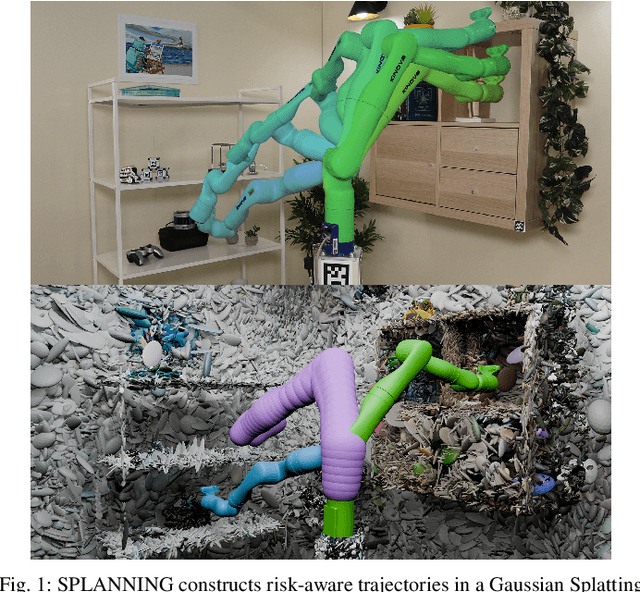

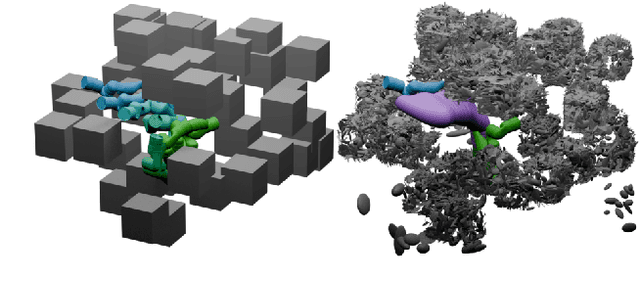

Abstract:Neural Radiance Fields and Gaussian Splatting have transformed the field of computer vision by enabling photo-realistic representation of complex scenes. Despite this success, they have seen only limited use in real-world robotics tasks such as trajectory optimization. Two key factors have contributed to this limited success. First, it is challenging to reason about collisions in radiance models. Second, it is difficult to perform inference of radiance models fast enough for real-time trajectory synthesis. This paper addresses these challenges by proposing SPLANNING, a risk-aware trajectory optimizer that operates in a Gaussian Splatting model. This paper first derives a method for rigorously upper-bounding the probability of collision between a robot and a radiance field. Second, this paper introduces a normalized reformulation of Gaussian Splatting that enables the efficient computation of the collision bound in a Gaussian Splat. Third, a method is presented to optimize trajectories while avoiding collisions with a scene represented by a Gaussian Splat. Experiments demonstrate that SPLANNING outperforms state-of-the-art methods in generating collision-free trajectories in highly cluttered environments. The proposed system is also tested on a real-world robot manipulator. A project page is available at https://roahmlab.github.io/splanning.
 Add to Chrome
Add to Chrome Add to Firefox
Add to Firefox Add to Edge
Add to Edge